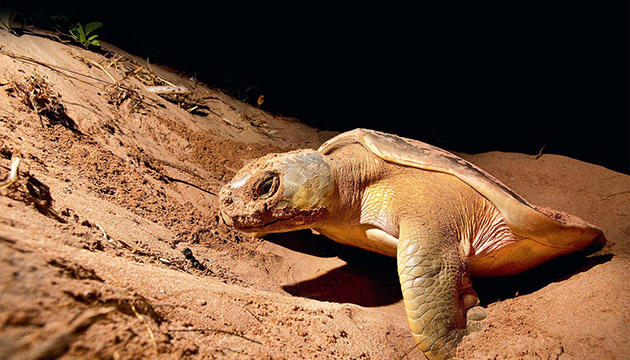Despite almost 35 years of bombing raids, Bare Sand Island remains an important breeding site for the vulnerable flatback turtle.
Story By David Hancock
Bare Sand Island, 50 kilometres west of Darwin, is an unlikely marine treasure. Each year about 30,000 turtles hatch from nests on the aptly named grassy stretch of sand less than two kilometres in circumference. From 1945 to 1979 Bare Sand Island, along with nearby Quail and Little Quail islands, was bombed and strafed by the Royal Australian Air Force (RAAF) for target practice, however flatback turtles continued to nest there as they have done for generations.
The Department of Defence is now searching for unexploded ordnance as part of a three-year clean-up program. Turtle researchers and the occasional sailor also visit the island, along with eco-tourism company Sea Darwin, which runs tours during the turtle-breeding season. Although five large unexploded bombs have been located, the beach and nearby dunes are regarded as safe. However, visitors are advised not to walk through the middle of the island where a lone tree stands beside a freshwater spring – a sacred site for the Larrakia people.
“Bare Sand Island has this special aura, especially in the evening and at night when the turtles come ashore on the high tide,” says Hannah Seward,
a guide for Sea Darwin and researcher and volunteer with AusTurtle. “It’s like a moonscape and the fact that you can see wildlife doing its thing undisturbed so close to Darwin is amazing.”
Between May and October female flatback turtles run a gauntlet of crocodiles and tiger sharks to lay their eggs on the island. They mate in deep water with different males and store their sperm before returning to the area where they themselves hatched. A female nests every two weeks, coming ashore up to five times during the season to produce eggs with a diversity of fathers. She nests just above the high-water mark on the first line of dunes where she digs a body pit and excavates an egg chamber the shape of a large vase and deposits 40 to 50 round, white, leathery eggs. After she covers her nest, the female creates a false nest about three metres away to distract predators.
This story excerpt is from Issue #81
Outback Magazine: Feb/Mar 2012










